|
August 28, 2006
Hello from Toronto: Discovering Casa Loma
and Sir Henry Pellatt, the Fascinating Man behind Toronto’s
Castle
As part of my “Celebrate Toronto” article series I
have set out with a goal of making one of the most complete discoveries
of this city, focussing on the people and places of Toronto. One
place cannot possibly be missing in this series: Casa
Loma, Toronto’s Castle, together with Sir Henry Pellatt,
one of Toronto’s most illustrious personalities.
Last Friday, on a somewhat drizzly day, I set out on my discovery
and met Lou Seiler who is the Director of Marketing for Casa Loma.
We sat down in the basement of the castle, formerly Sir Henry Pellatt’s
exercise room, which today houses a cafeteria. Lou started to fill
me in on the building, its history and its interesting owner. Sir
Henry Pellatt, born in 1859 in Kingston of English parents, was
a successful Toronto financier, industrialist and military officer.
His father had started a stock brokerage which Henry joined at the
young age of 23, embracing the family motto “Devant Si Je
Puisse – Foremost if I can”. Pellatt married his childhood
sweetheart, Mary Dodgson, with whom he had one son, Reginald. Lady
Pellatt later distinguished herself as the first commissioner of
the Girl Guides. Henry Pellatt was very loyal to the British Queen
and became a general with the Queen’s Own Rifles, a military
regiment within the Canadian Armed Forces.
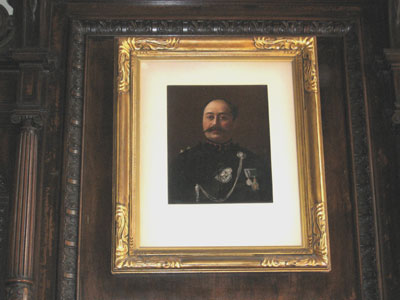
Sir Henry Pellatt
It was very early on that Henry Pellatt demonstrated his business
acumen: he founded the Toronto Electric Light Company in 1883, the
same year that Thomas Edison developed steam-generated electricity.
This company was responsible for providing electric lighting and
street cars on the streets of Toronto. After his father’s
death in 1892, he was able to make even more aggressive investments
and guessed right on the money when he purchased stock in the Canadian
Pacific Railroad and the North West Land Company. Business colleagues
used to call him "The Plunger" since he had a habit of
plunging head-first into the next promising business venture. His
astute decisions assured his path to financial success.
By 1901 Henry Pellatt was chairman of 21 major companies with interests
in mining, insurance, real estate and electricity. As a single person
he directly controlled 25% of Canada’s economy. His entrepreneurial
spirit continued and together with some business partners he built
the first hydro-generating plant at Niagara Falls in 1902. Henry
Pellatt was knighted in 1905 by King Edward V for his service to
the Queen and his efforts in bringing electricity to the people
of Canada.
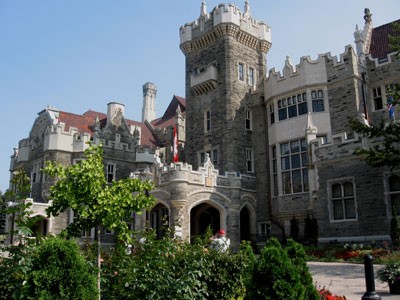
Front entrance of Casa Loma
In the early 1900s Sir Henry Pellatt was one of Canada’s
richest men and his high aspirations also extended to his personal
life: he aimed to build a real castle by the name of “Casa
Loma” – “house on the hill”. Construction
on the complex started in 1906 and the first structure to be completed
was the Pellatt Hunting Lodge. As Sir Henry was an avid horseman,
the Stables were next on the construction schedule. Finally, the
castle itself was built between 1911 and 1913. It cost 3.5 million
dollars (about 60 million dollars in today’s money), took
nearly 300 men almost 3 years to complete and incorporates a variety
of architectural styles that inspired Pellatt on his trips to Europe.
Despite being one of the most influential men in Canada, Sir Henry
Pellatt enjoyed socializing with common people. He was very generous
to his employees, about 40 of whom were employed at Casa
Loma. He even built a skating rink for them on the terrace of
the Castle. Sir Henry was known to be a gregarious and outgoing
individual.
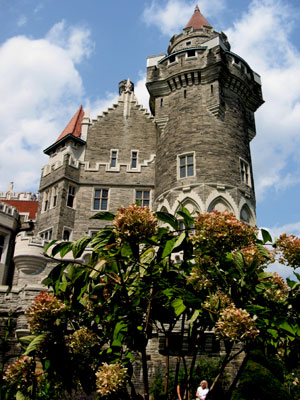
Casa Loma from the garden
However, Pellatt’s magic touch did not last forever: with
the creation of the Ontario Hydro Electric Commission, power generation
was transferred into the public sector. As a result, Sir Henry Pellatt
and his business partners were expropriated without any compensation
whatsoever. In addition, one of his other businesses, an aircraft
manufacturing company, was also taken over by the government, again
without compensation, as part of the war effort in WWI.
To make up for these losses, Pellatt went into land development
west of St. Clair and Spadina, but around 1919 he was facing a major
recession and his real estate dealings went sour. He owed the Home
Bank of Canada $1.7 million – or $20 million in today’s
currency. The bank went bankrupt as a result and in 1924 creditors,
first and foremost the City of Toronto, turned to the castle to
recover their unpaid property taxes. Although they were unable to
seize the castle, as it was in Lady Pellatt’s name, all the
movable property, furnishings and artwork were sold off at fire
sale prices. As a consequence Sir Henry and Lady Mary Pellatt had
to abandon their dream castle and moved to a farm in King City.
Lady Pellatt passed away shortly after at the age of sixty-seven.
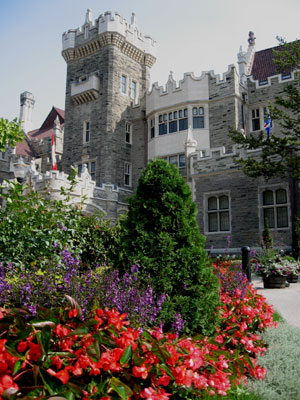
The flowers are in full bloom
In 1927, Casa Loma was bought by a New York syndicate and turned
into an upscale hotel. However, this only lasted for 18 months,
the stock market crash of 1929 and the ensuing depression put quite
a damper on the high-end hotel business for a while. Sir Henry ended
up getting the castle back, but as his wife had died in the meantime
the City of Toronto, one of the castle’s main creditors, seized
the building for $27,000 worth of unpaid realty taxes.
The city did not know what to do with the building and let it sit
unoccupied for 10 years until finally in 1937, the Kiwanis Club
stepped in and offered to run it on behalf of the city. Sir Henry
meanwhile in his later years was almost destitute and ended up living
with his former chauffeur in a modest bungalow in Etobicoke, one
of Toronto's suburbs. However, Sir Henry's role and historic importance
were not forgotten: upon his death in 1939, he received the largest
funeral Toronto had ever seen up to this point. Thousands of people
lined Toronto streets to catch a glimpse of his funeral procession
and he was buried with full military honours.
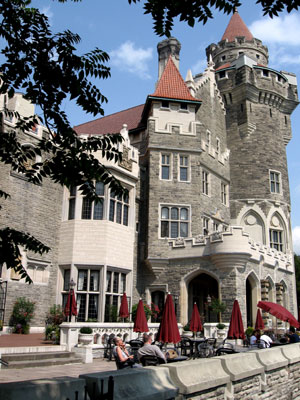
The beautiful terrace on the south side of the castle
Since 1937 the Kiwanis Club has been running Casa Loma, and through
astute management of the complex has turned Casa Loma into the second
largest tourist attraction in Toronto, with about 400,000 visitors
a year, generating about $21 million in revenue for the city and
surrounding merchants. Net proceeds from the museum go to children’s
charities run by the Kiwanis Club. In the operation of Casa Loma,
the Kiwanis Club has four major mandates:
1. Tourism: the castle is accessible as a day-time tourist attraction
until 5 pm.
2. Catering and functions: more than 130 weddings are held here
annually, and 240 additional corporate and media events take place
at Casa Loma every year.
3. The castle is a major film location and movies such as X-Men,
Chicago and many others have been shot here.
4. Casa Loma also serves the community by providing the backdrop
for grade 4 students in medieval history and plays host to many
other community events.
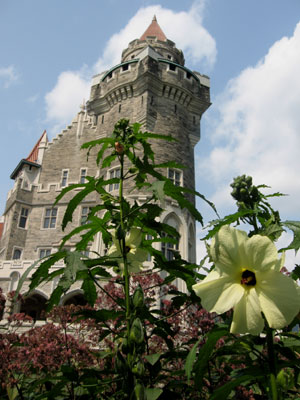
Medieval splendour in 21st century Toronto
Before we headed off on our actual tour, Lou also shared with me
the future vision for Casa Loma: the Kiwanis Club would like to
develop the entire surrounding area into an “Estate District”
which would encompass the former estates of three of Toronto’s
leading families: The Austins at Spadina, the Eatons at Ardworld,
and the Pellatts at Casa
Loma. The vision calls for an upscale restaurant in the Hunting
Lodge, and integration with the Toronto Archives Theatre, creating
a gateway to the District with an introductory film on all three
families. Several entrance points would be provided to the “Estate
District”, including a plan for a funicular railway. Lou indicated
that currently there is an unused funicular railway in Niagara Falls
that could be brought in for this purpose. Art Gardens would be
developed on the hillsides, including period arbours and pergolas,
and a Themed Artists Mall would be located on the north side of
Davenport Road. Themed tourism is an important travel industry trend
draw and an entire ”Estate District” would be a major
attraction for out-of-town travelers coming to Toronto.
As I had just recently visited Toronto's
Distillery District, I understood the concept of "themed
tourism" which builds an entire group of attractions around
one common theme in a coherent vision, in this case some of Toronto's
most influential families and their estates. I was quite impressed
by the scope and creativity of the Kiwanis proposal and maybe one
day we will see an entire district celebrating Toronto's foremost
families.
After this great introduction it was time to explore
these fascinating buildings first-hand.
Useful books about Toronto:
Related articles:
Toronto - A pretty
hip place
Toronto - Sights,
Culture, Shopping
Toronto - Festival,
parks, sports and recreation
Check out why I love Toronto
An interview with Doors Open
- Toronto's architecture festival
My visit to Doors
Open 2005
My visit to Toronto's 2005
Celebrate Toronto Festival
A tour through Toronto's historic
Saint Lawrence Market
An interview with Caribana,
Toronto's Caribbean festival
An interview with Pride
Toronto
Looking forward to my brother's
visit to Toronto
Hello from Toronto (2) - Exploring
the waterfront by bicycle and the CN Tower
Hello from Toronto (3) - Exploring
Niagara Wine Country and Niagara Falls
Hello from Toronto (4) - Exploring
Toronto's west end neighbourhoods
Hello from Toronto (5) - Novice golf,
exploring the Kawarthas, & a final bike ride
Here are my
reflections after my European visitors left
An interview with the Toronto
Wintercity Festival
Images of Toronto during the winter
of 2006
My visit to Doors Open 2006
Checking out the Taste
of Little Italy 2006
My visit to the 2006
Celebrate Toronto Street Festival and Afrofest
Toronto sizzles in the summer
of 2006
A visit of Toronto's
Distillery District
Casa Loma & Sir Henry Pellatt:
the man behind the castle
First-hand discoveries of the nooks
and crannies at Casa Loma
A behind the scenes look at the Royal
York Hotel
|